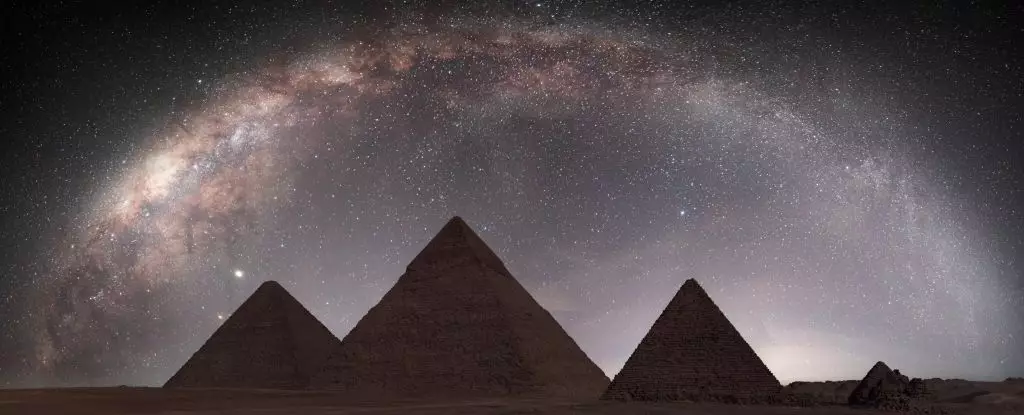The nighttime sky has always captivated human imagination, an endless expanse of mystery that beckons exploration and contemplation. In recent years, an intriguing intersection has arisen between ancient art and modern astronomy, particularly concerning the Egyptian sky goddess Nut. Astrophysicist Or Graur of the University of Portsmouth has profoundly explored how ancient Egyptian depictions of Nut may articulate a deeper understanding of the cosmos, specifically the Milky Way. This exploration reveals not just artistic interpretation but also showcases the advanced astronomical insights possessed by ancient civilizations, urging us to reevaluate their scientific capabilities.
The significance of Nut transcends mere symbolism; she embodies the sky itself, often illustrated in captivating art from as far back as 4,600 years ago. Nut’s form, stretched protectively over scenes of life and death, serves a dual purpose: as a deity providing comfort in the afterlife and as a cosmic representation channeling celestial movements. Graur’s analysis of over hundreds of decorated coffins unveils striking parallels between Nut and the galactic plane—an idea that could fundamentally reshape our understanding of ancient Egyptian cosmology.
The Great Rift: A Celestial Revelation
Among the artifacts examined by Graur, the coffin of Nesitaudjatakhet—a singer revered for her devotion to Amun-Re—stood out with a remarkable depiction of Nut. The painting vividly illustrates a long, serpentine line tracing the goddess’s body, flanked by stars that possibly correlate with our own Milky Way’s structure. Graur proposes that this undulating line symbolizes the Great Rift, a dark band that segments the luminous expanse of the Milky Way, visually reflecting the night sky that the ancient Egyptians would have experienced.
This hypothesis sparked intrigue due to its rare nature; only a handful of artistic representations within the extensive coffin analysis showcase Nut with this specific cosmic feature. Graur pointedly notes that while the connection between Nut and the Milky Way exists, it does not imply that the goddess is simply a portrayal of the galaxy. Instead, Nut embodies a rich tapestry of celestial phenomena, incorporated into her identity as a manifestation of the sky. This distinction presents an opportunity to delve deeper into how ancient Egyptians understood and interpreted their universe, suggesting they were not only observers but thinkers grappling with complexities that resonate with modern scientific inquiry.
Interdisciplinary Insights and the Value of Collaboration
Graur’s findings emphasize the crucial role of interdisciplinary research in fostering a deeper understanding of history. The blend of art history, archaeology, and astrophysics illuminates pathways to knowledge that single-discipline approaches might overlook. It raises a pertinent question: how much valuable knowledge remains undiscovered within the intersection of differing fields? By bridging these realms, researchers can exercise a holistic approach that not only enriches our comprehension of ancient artifacts but also challenges preconceived notions about the civilizations that created them.
The complexity of Nut’s cosmic representation encourages a reevaluation of how we interpret religious symbols and their connections to natural phenomena. They were not mere decorations; they were profound reflections of a culture’s interaction with the universe. By examining how ancient Egyptians depicted and understood their gods, we can glean insights into their worldview, perhaps leading us to ponder our own celestial relationships.
The Call for Accessibility in Research
Furthermore, Graur argues vehemently for the digitization of museum catalogs to aid in research accessibility. Many historical artifacts remain under-digitized or completely inaccessible, limiting scholarly engagement and public understanding. By advocating for a comprehensive and publicly available database, he proposes a future where interdisciplinary research can flourish even further, enabling global discourse surrounding ancient art and its scientific implications. Such improvements could empower budding scholars and enthusiasts, granting them access to the vast reservoir of knowledge that art and science hold together.
As we peel back the layers of ancient Egyptian artistry, we must remain aware of our own biases—modern interpretations can often distort historical truths. Graur’s study urges us not only to unearth new findings but to pause and reflect on the implications of those findings. How we view Nut and her connection to the Milky Way may reshape not just our perspective on ancient civilizations but also inspire a newfound respect for the intertwined web of spirituality and science that persists to this day. As we expand our comprehension of these cosmic relationships, we also embrace a broader, enriching view of humanity’s perennial quest for understanding the universe.

